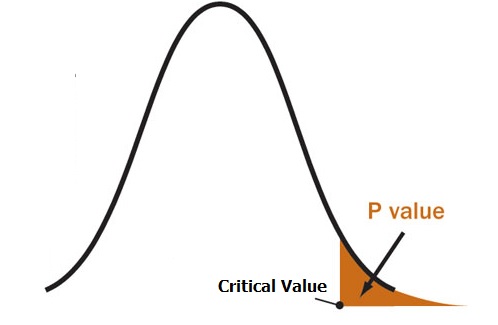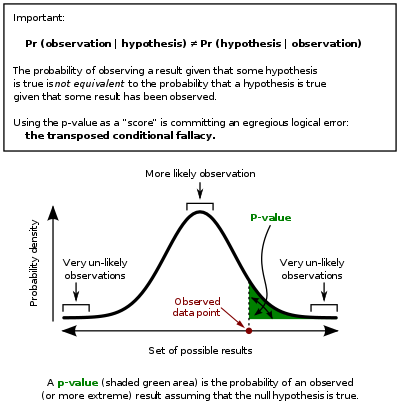p value - SoojungHong/StatisticalMind GitHub Wiki
What is P-value?
A p value is used in hypothesis testing to help you support or reject the null hypothesis. The p value is the evidence against a null hypothesis. The smaller the p-value, the strong the evidence that you should reject the null hypothesis.

P-value and Alpha value
Alpha levels are controlled by the researcher and are related to confidence levels.
A small p (≤ 0.05), reject the null hypothesis. This is strong evidence that the null hypothesis is invalid.
A large p (> 0.05) means the alternate hypothesis is weak, so you do not reject the null.
Explain in detail
When you test a hypothesis about a population, you can use your test statistic to decide whether to reject the null hypothesis, H0. You make this decision by coming up with a number, called a p-value. A p-value is a probability associated with your critical value. The critical value depends on the probability you are allowing for a Type I error. It measures the chance of getting results at least as strong as yours if the claim (H0) were true.
The following figure shows the locations of a test statistic and their corresponding conclusions.


The p-value is a number between 0 and 1 and interpreted in the following way:
-
A small p-value (typically ≤ 0.05) indicates strong evidence against the null hypothesis, so you reject the null hypothesis.
-
A large p-value (> 0.05) indicates weak evidence against the null hypothesis, so you fail to reject the null hypothesis.
-
p-values very close to the cutoff (0.05) are considered to be marginal (could go either way). Always report the p-value so your readers can draw their own conclusions.
A p-value is the probability that the results from your sample data occurred by chance. P-values are from 0% to 100%. They are usually written as a decimal. For example, a p value of 5% is 0.05. Low p-values are good; They indicate your data did not occur by chance. For example, a p-value of .01 means there is only a 1% probability that the results from an experiment happened by chance. In most cases, a p-value of 0.05 (5%) is accepted to mean the data is valid.